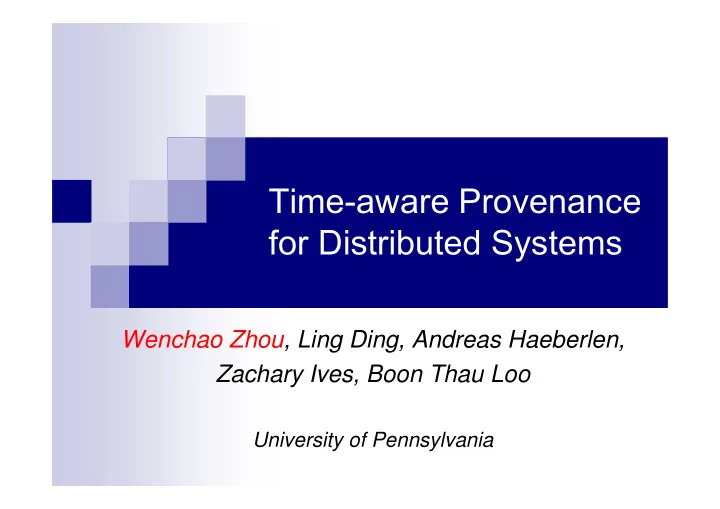

Time-aware Provenance for Distributed Systems Wenchao Zhou, Ling Ding, Andreas Haeberlen, Zachary Ives, Boon Thau Loo University of Pennsylvania
Provenance for Distributed Systems Goal: Develop capability to answer diagnostic questions We need to tackle additional challenges… • Provenance in transient and inconsistent state • Explanation for state changes • Security without trusted nodes • Nodes may be compromised by the attacker 2
Provenance in Dynamic Environments Why did node c’s route to node a change? � Reason - insertion of link(a,b,1) � Provenance for system state � Not track dependency between changes � Possible solution: differencing the current provenance with a previous version. � But, what about a deletion? No current version to compare…
Provenance in Dynamic Environments c: minCost(@c,a,4) b: minCost(@b,a,3) Who is right? � Explicitly capture time � Handle question asked when the system is in transient state � Consistent view of the provenance graph
Time-aware Provenance � Explicitly capture causalities between state changes � Explain the INSERT / DELETE of tuples � Event-based execution triggered by state changes sp2: pathCost(@Z,D,C1+C2) :- link(@S,Z,C1), minCost(@S,D,C2). sp2a: ∆ pathCost(@Z,D,C1+C2) :- link(@S,Z,C1), ∆ minCost(@S,D,C2). sp2b: ∆ pathCost(@Z,D,C1+C2) :- ∆ link(@S,Z,C1), minCost(@S,D,C2). 5
Time-aware Provenance � Explicitly capture causalities between state changes � Explain the INSERT / DELETE of tuples � Event-based execution triggered by state changes � Update due to constraints (primary keys, aggregation) sp3: minCost(@S,D,MIN<C>) :- pathCost(@S,D,C). insertion of minCost(@c,a,4) caused deletion of minCost(@c,a,5) 6
TAP Provenance Model Why did node c’s route to node a change? Update due to constraints Rule triggering link(@b,c,3) exists in time [t1, t2] 7
Provenance Maintenance � Provenance with temporal dimension Maintenance vs. Querying performance � Versions of provenance � Expensive – provenance explosion � Active maintenance � Provenance deltas – deltas between adjacent versions � Incrementally applied in querying � Reactive maintenance � Input logs – communications and update of base tuples � Reconstruct provenance by deterministic replay � Long-running systems? Periodic snapshots 8
Secure Provenance Querying � Byzantine adversaries � May have compromised an arbitrary subset of the nodes � May have complete control over the nodes – arbitrary behavior � Guarantees � Idealism: Always get correct forensics results (not possible!) � Practicality: The conservative model requires compromises � May be incomplete, but, it will identify at least one faulty node 9
Thank You …
Recommend
More recommend